Dyster had his own wire walker; paid $14,000 for little-known event
By Frank Parlato
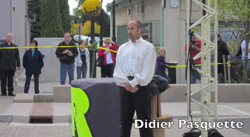 |
| Dyster to Pasquette: glad to pay for this, you thrilling man, you. |
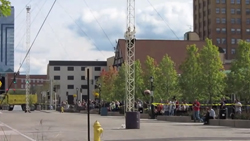 |
| Better than Wallenda? See the tiny crowd? Quality, not quantity! |
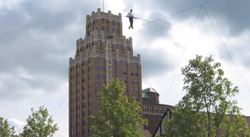 |
| Dyster was willing to pay for this wire walker but sent a bill to Wallenda. |
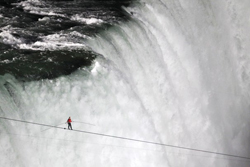 |
| Dyster to Wallenda: Listen fool. you're no Didier Pasquette. |
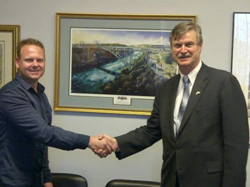 |
| “I’ll shake this Wallenda guy’s hand for a photo op, but we ain't paying for this Wallenda chap. Now when we can pay to have Didier Pasquette! |
You gotta love this.
On the one hand, Niagara Falls Mayor Paul Dyster sent Nik Wallenda a bill for $25,151.31.
Yes, 31 cents. So frugal and careful with our money is this mayor.
On the other hand, Dyster gladly spent $14,000 of taxpayer money to hold his own wire walk event – something very few people knew about.
Wallenda promised his tightrope crossing over Niagara Falls would generate untold millions in free publicity for a struggling corner of upstate New York.
It did.
The bill he got from the city was for overtime for police and firemen Dyster said the city needed to make sure the crowds attracted to Wallenda’s wire walk would be safe.
There was no bill however for overtime for Dyster’s wirewalk event- since there was hardly a soul there.
The Associated Press, The New York Times, Fox News, Washington Examiner, London Times, Australia, India, Europe, Japan, almost everyone in the world people heard about or saw Wallenda walk the wire over Niagara Falls on June 15.
Sports Illustrated, among thousands of others, published stunning pictures showing the falls in a light many had never seen before.
ABC’s live television broadcast was, according to the Hollywood Reporter, the “Most watched non-sports summertime major telecast since 2006.”
ABC attracted 10.1 million viewers from 9–11 p.m. the night of the wire walk, according to reports.
“Mr. Wallenda’s 1,800-foot crossing transfixed a national television audience and generated a wave of publicity that the falls had not experienced in decades,” wrote the New York Times. “It seemed like a particular coup for the economically depressed American side of the falls, creating an instant hero and a point of pride for a city that has lost more than half its population in the last half century.”
Many of the same news outlets that carried news of the walk later reported how Dyster dunned Wallenda with his $25,151 (and don’t forget the 31 cents) bill.
WGRZ Television reported Dyster’s “spat” on Jul 24, 2012:
“A month after Niagara Falls was put in the global spotlight by Nik Wallenda's prime-time tightrope walk, the walk into history is once again making headlines around the continent. This time, however, the headlines are not so glowing.”
The New York Times wrote, “A month after his stunt, Mr. Wallenda and the mayor of Niagara Falls are locked in an increasingly bitter dispute”
In the Times story, Wallenda spoke of the difference in treatment he received from Dyster and Niagara Falls, Ont., Mayor James Diodati, adding “That’s why New York looks the way it does and Canada looks the way it does. Because of that (petty, ungrateful) attitude.”
Of course, Dyster was against Wallenda’s walk from day one.
The New York Post wrote on July 5, 2011. “Dyster has said his economically struggling city needs to take into account concerns that the (tightrope) event could be perceived as a ‘sideshow’ to the falls,”
On May 3, 2012, The Niagara Gazette wrote, “It is common knowledge that Dyster was opposed to the Wallenda walk from the outset.”
New York State Senator George Maziarz and NFR Executive Vice President Roger Trevino arranged and executed the idea of having the world’s premier high-wire artist cross the falls. These men are not political supporters of Dyster.
On top of it there is talk of Wallenda, with help from Trevino and Maziarz, doing a large-scale attraction here. It would not be a feather in Dyster’s cap if someone did such a project without Dyster’s input and without needing public money.
Now here’s the funny part: Back on Aug. 27, 2010, Mayor Dyster brought a funding request to the City Council for his own wire walk.
His request for funding read:“The Buffalo Arts Studio has requested a grant of $14,000 to help pay Didier Pasquette’s Wire Walk in Niagara Falls, New York as part of a Collaborative Regional Biennial Contemporary Exhibition called Beyond/In Western New York 2010.
“This Wire walk will take place at a location to be mutually agreed upon on a date to be agreed mutually upon between September 24, 2010 and January 16, 2010. Funding is available from Tourism Fund balance.
“Will the Council so approve and authorize the Mayor to execute the same?
“Respectfully submitted
“Paul A Dyster.”
In what is an unintentionally funny headline, the Niagara Gazette’s September 7, 2010 report of the council meeting where the $14,000 wire walk expenditure was approved began with the headline “Council imposes freeze on non-essentials”
It reads: “… Council members on Tuesday unanimously approved a measure imposing a freeze on all discretionary spending through Dec. 31.
“It is hoped the move will allow the city to end the year with a larger fund balance, providing council members with more money to work with as they begin putting together the municipal spending plan for 2011….
“Under the directive, all city department heads will be expected to cease spending on discretionary items such as clothing, supplies and travel even if their respective budgets show a surplus….
“Mayor Paul Dyster told lawmakers his administration has already taken steps of its own to curtail spending …
“In other matters, the council:
“Agreed to honor a request from the Buffalo Arts Studio for a $14,000 grant to help pay Didier Pasquette’s “Wire Walk” in Niagara Falls. …”
Glad to know the Mayor and council felt a wire walk is essential.
In fact, Dyster told the Buffalo News how important wire walks are in Niagara Falls.
In an article published on Sept. 23, 2010, Dyster said "We have a very long history of tightrope walking in Niagara Falls, and we hope it causes people to take a new look at the history of it and that it reawakens interest in Niagara Falls as a backdrop for visual and performance art."
So, on the one hand, you have the mayor talking about our legacy of tightrope walking. Then a year later he says Wallenda will make the falls a “sideshow” by doing a tightrope walk.
The Pasquette walk, by the way, did occur, but almost a year late. You may not have heard of it because there was little or no press about it.
A search of Google produced not a single news report about the actual wire walk of Didier Pasquette in Niagara Falls. The only proof the Reporter could find online was a YouTube video. https://www.youtube.com/watch?v=VCg3sqa9nOA
This video, viewed by 4,877 people shows that on Sept. 26, 2011, Pasquette climbed a structural steel ladder with a platform , on Old Falls Street and walked approximately 200 feet of wire for three minutes then climbed down a second ladder.
He was 45 feet in the air.
As he comes down, he gets modest applause and you can count the crowd if you pause the video. There were 63 people who attended.
Mayor Dyster spent $14,000 of City money for Pasquette who attracted 63 people, and no press.
But sent a bill to Wallenda for an event that 100,000 people attended, 10.1 million more watched on ABC and an unknown number of millions took a new look at the history of tightrope walking in the falls and had their interest reawakened.
And for Wallenda’s good services Dyster sent him a bill for 41 policemen including a “Crime Analyst” (9 hours at $265.95) and 25 Firemen, including two trainers to train the firemen- all at overtime.
According to a Google search using the words “Wallenda” and “Niagara Falls,” Google reports 805,000 websites mention these two.
A search for “Didier Pasquette” and “Niagara Falls” shows five.